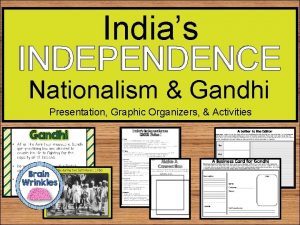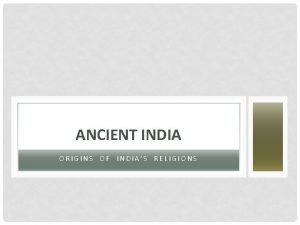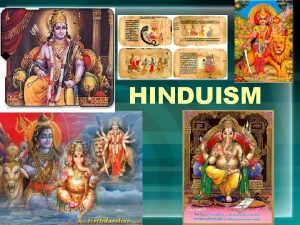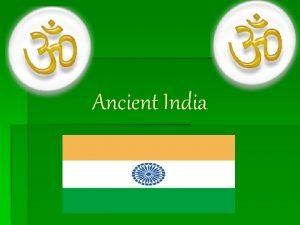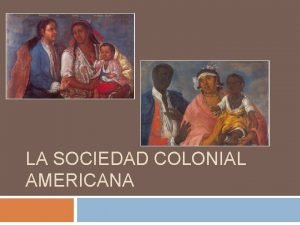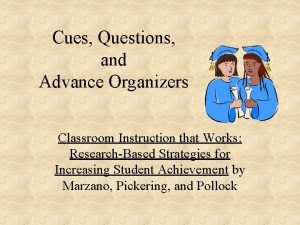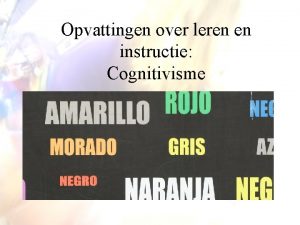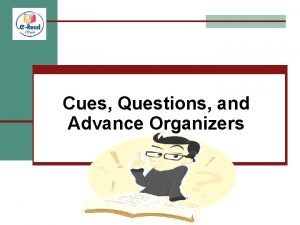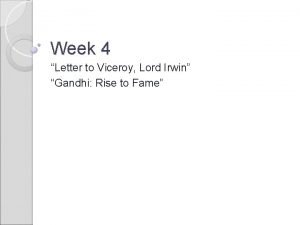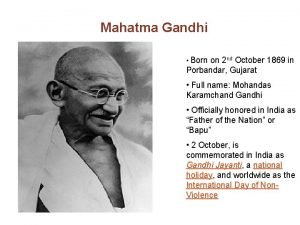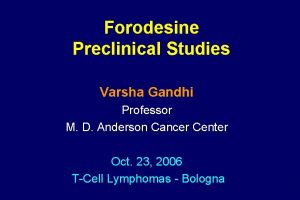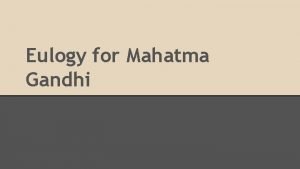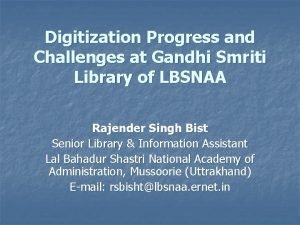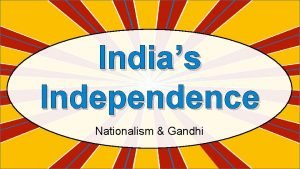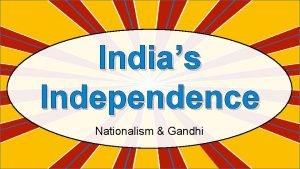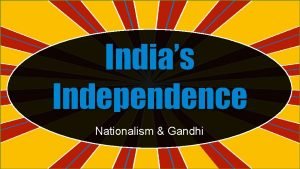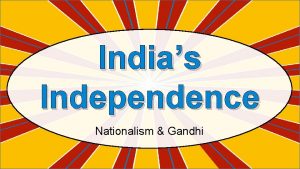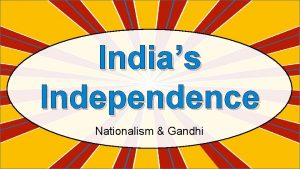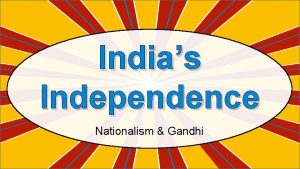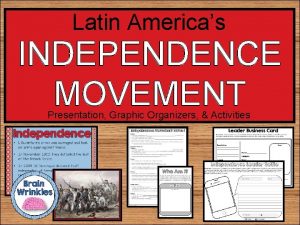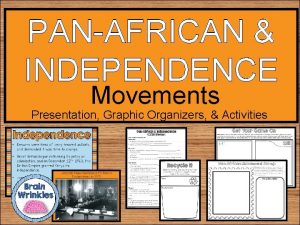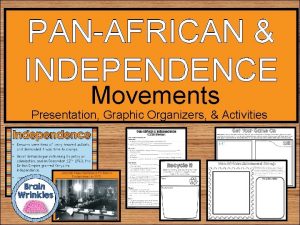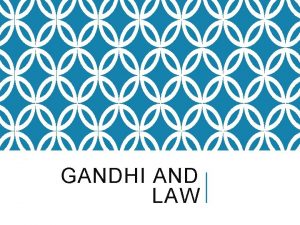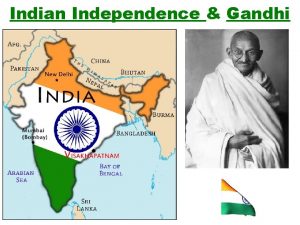Indias INDEPENDENCE Nationalism Gandhi Presentation Graphic Organizers Activities












































- Slides: 44

India’s INDEPENDENCE Nationalism & Gandhi Presentation, Graphic Organizers, & Activities

STANDARDS: SS 7 H 3 Analyze continuity and change in Southern and Eastern Asia. a. Describe how nationalism led to independence in India. b. Describe the impact of Mohandas Gandhi’s belief in non-violent protest. © Brain Wrinkles

India’s Independence © Brain Wrinkles

Trading • In 1601, the British business, East India Trading Company, arrived in India and began setting up trading posts. • Great Britain began trading with India in the 1660 s. • At first, the British were only interested in trading goods (ivory, gold, silks, dyes) and spices (cinnamon, saffron, pepper, sugar, vanilla). © Brain Wrinkles

Sir James Lancaster commanded the first East India voyage in 1601. © Brain Wrinkles

A Colony • By 1760, Great Britain had gained economic and political control over India. • Great Britain official took control of the entire country when it declared India a colony of the British empire in 1765. © Brain Wrinkles

© Brain Wrinkles

© Brain Wrinkles

Colonial Life • Great Britain took complete authority over the colony and denied Indians any role in the government of their nation. • Indians were treated as second-class citizens in their own country. • There was inequality under British laws. © Brain Wrinkles

© Brain Wrinkles

Colonial Life • Indians also faced discrimination and unjust treatment in British society. • The best jobs and schools were only available to the British. • Indians were also taxed heavily by the British on goods that were found in their own country. © Brain Wrinkles

© Brain Wrinkles

Resentment • Indians began to resent being ruled by a foreign government and began to protest for changes. • Great Britain eventually offered some reforms, but they were small and not enough. • Indians were frustrated with the lack of change, and began to call for Indian independence. © Brain Wrinkles

© Brain Wrinkles

Nationalism • In the 1800 s, a feeling of nationalism grew in India. • Nationalism is a belief that people should be loyal to those with whom they share common history and customs. • The first two groups to work for the rights of Indians were the Indian National Congress in 1885 and the Muslim League in 1906. © Brain Wrinkles

The First Indian National Congress, 1885 © Brain Wrinkles

WWI’s Impact • During World War I, millions of Indians joined with the British army. • The British Parliament promised them that when the war ended, Indians would be able to have more control of their government. © Brain Wrinkles

Indian Medic Troops During WWI © Brain Wrinkles

Protests • Unfortunately, nothing really changed after the war and some Indian leaders argued for taking over the British government by force. • Many Indians were upset with the British false promises. • Those who protested were arrested and sent to jail for up to two years without a trial. © Brain Wrinkles

Amritsar • In 1919, outside of the Temple of Amritsar, British soldiers started shooting a large group of Indians who they claimed were “gathering illegally”. • During this terrible tragedy, over 400 people were killed and 1200 were injured. • It was this awful massacre that spurred Mohandas Gandhi into action to fight for India’s independence. © Brain Wrinkles

© Brain Wrinkles

Jallianwala Memorial – Amritsar © Brain Wrinkles

Gandhi • Mohandas Karamchand Gandhi was born in India on October 2 nd, 1869 and studied law in England. • After practicing law in South Africa during Apartheid, he returned to India in 1914 with a determination that people should be treated equally, no matter their race or religion. • He was shocked by the way Indians were segregated and oppressed by British authorities. © Brain Wrinkles

Lawyer Mohandas Gandhi 1909 © Brain Wrinkles

Gandhi • After the Amritsar massacre, Gandhi quit practicing law and decided to devote his life to fighting for the equality of all Indians. • He was enraged at how the British discriminated against Indians. • Gandhi believed it was time for the people of India to stop obeying the unjust British laws. © Brain Wrinkles

Nonviolence • Gandhi did not think that forceful resistance was the right path for Indian independence. • Instead, he encouraged his followers to practice nonviolent protests against the British in order to bring about social change. • Gandhi encouraged Indian followers to disobey unjust British laws in a peaceful manner, without using violence. © Brain Wrinkles

God is truth the way to truth lies through Ahimsa (non-violence). Sabarmati, March 13, 1927 M K Gandhi © Brain Wrinkles

Social Change • Gandhi developed what he called a “system of civil disobedience” and believed that it would make the world recognize the injustice in India and force change without using violence. • He believed that acts of goodness produced positive reactions while violence only produced negative ones. • Gandhi led his followers in economic boycotts, hunger strikes, and nonviolent protests to oppose the unfair treatment of Indians. © Brain Wrinkles

Gandhi on strike with textile workers in 1931. © Brain Wrinkles

Salt March • In 1930, Gandhi led a 240 -mile march to the ocean to oppose a British tax on salt. • Guards responded by clubbing and beating the peaceful protestors. • News of this event spread worldwide and people around the world began to call for the British to grant Indian independence. © Brain Wrinkles

Gandhi during the Salt March, 1930. © Brain Wrinkles

Support • Even though Gandhi and his followers practiced non-violence, the British authorities did not. • The Indian protestors suffered brutal beatings and long prison sentences. • Despite the dangers, more and more Indians followed Gandhi’s wisdom of non-violent resistance and generated support for nationalism and independence. © Brain Wrinkles

© Brain Wrinkles

© Brain Wrinkles

Independence • After fighting in WWII, Britain no longer had enough money or people to keep India under its control. • Great Britain finally agreed to give up their colonial claims to India. • On August 15, 1947, the Republic of India was established. • Today, many Indians credit India’s independence to the efforts of Gandhi. © Brain Wrinkles

India’s Independence Day © Brain Wrinkles

Many Indians lovingly call Mohandas Gandhi Mahatma, or “great soul” Late 1930 s © Brain Wrinkles

Split India • Even though India had won its independence, things were not peaceful in the country. • Hindus and Muslims could not reach a solution as to how to rule an independent India. • Eventually, the country was split into India for the Hindus and Pakistan for the Muslims. © Brain Wrinkles

© Brain Wrinkles

Two Muslim men carrying an elderly woman to their new home in Pakistan. © Brain Wrinkles

Turmoil • The partition of India led to genocide; hundreds of thousands of people were killed in widespread violence. • Gandhi was very much disappointed by the partition because he wanted all Indians to live together peacefully in one country. • Even though he was Hindu, he felt that all religious groups should be welcomed in India. © Brain Wrinkles

Time Magazine cover representing the partition of India - 1947. © Brain Wrinkles

Gandhi • In 1948, at the age of 78, Mohandas Gandhi was assassinated on his way to a prayer meeting in New Delhi. • He was shot three times by a highranking Brahmin who resented Gandhi’s concern for Muslims. © Brain Wrinkles

Memorial where Mohandas Gandhi was assassinated. © Brain Wrinkles
 Science staar supplemental aids
Science staar supplemental aids Tea blank graphic organizers
Tea blank graphic organizers Tea blank graphic organizers
Tea blank graphic organizers Hierarchical topical organizer
Hierarchical topical organizer Dese mcas reference sheets
Dese mcas reference sheets Marzano graphic organizers
Marzano graphic organizers Blank graphic organizers for math staar
Blank graphic organizers for math staar Marzano graphic organizers
Marzano graphic organizers Mcas accommodations
Mcas accommodations Gandhi presentation
Gandhi presentation Indias religions
Indias religions Indias religions
Indias religions Indias major religion
Indias major religion Indias first empire
Indias first empire Indias first civilization
Indias first civilization Flota de indias ruta
Flota de indias ruta Rules of the caste system
Rules of the caste system Sociedad colonial americana
Sociedad colonial americana The maurya and gupta empires
The maurya and gupta empires Graphic weight examples
Graphic weight examples Ghost graphic story graphic and wayfinding
Ghost graphic story graphic and wayfinding Skimming organizer example
Skimming organizer example Narrative advance organizer example
Narrative advance organizer example Expository advance organizers examples
Expository advance organizers examples Dear organizers
Dear organizers Discourse organizing words
Discourse organizing words Cues questions and advance organizers
Cues questions and advance organizers Cues questions and advance organizers
Cues questions and advance organizers Problem solving videos
Problem solving videos Operating activities vs investing activities
Operating activities vs investing activities How do you find these activities
How do you find these activities Support activities and primary activities
Support activities and primary activities Primary activities and tertiary activities
Primary activities and tertiary activities Free time activities presentation
Free time activities presentation Gandhi puvvada
Gandhi puvvada Gandhi letter to the viceroy answers
Gandhi letter to the viceroy answers Gandhi letter to lord irwin rhetorical analysis
Gandhi letter to lord irwin rhetorical analysis Nelson mandela and gandhi venn diagram
Nelson mandela and gandhi venn diagram Brief life sketch of mahatma gandhi
Brief life sketch of mahatma gandhi Cuando nacio mahatma gandhi
Cuando nacio mahatma gandhi Savannah bukant
Savannah bukant Varsha gandhi, ph.d.
Varsha gandhi, ph.d. Gandhi eulogy
Gandhi eulogy Gandhi smriti library
Gandhi smriti library Gandhi king and mandela what made non-violence work dbq
Gandhi king and mandela what made non-violence work dbq









